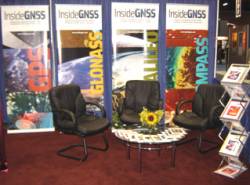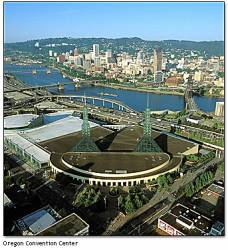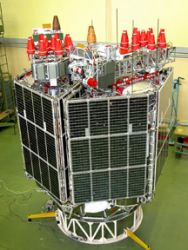 One of 12 magnetograms recorded at Greenwich Observatory during the Great Geomagnetic Storm of 1859
One of 12 magnetograms recorded at Greenwich Observatory during the Great Geomagnetic Storm of 1859 1996 soccer game in the Midwest, (Rick Dikeman image)
1996 soccer game in the Midwest, (Rick Dikeman image)
 Nouméa ground station after the flood
Nouméa ground station after the flood A pencil and a coffee cup show the size of NASA’s teeny tiny PhoneSat
A pencil and a coffee cup show the size of NASA’s teeny tiny PhoneSat Bonus Hotspot: Naro Tartaruga AUV
Bonus Hotspot: Naro Tartaruga AUV
 Pacific lamprey spawning (photo by Jeremy Monroe, Fresh Waters Illustrated)
Pacific lamprey spawning (photo by Jeremy Monroe, Fresh Waters Illustrated) “Return of the Bucentaurn to the Molo on Ascension Day”, by (Giovanni Antonio Canal) Canaletto
“Return of the Bucentaurn to the Molo on Ascension Day”, by (Giovanni Antonio Canal) Canaletto The U.S. Naval Observatory Alternate Master Clock at 2nd Space Operations Squadron, Schriever AFB in Colorado. This photo was taken in January, 2006 during the addition of a leap second. The USNO master clocks control GPS timing. They are accurate to within one second every 20 million years (Satellites are so picky! Humans, on the other hand, just want to know if we’re too late for lunch) USAF photo by A1C Jason Ridder.
The U.S. Naval Observatory Alternate Master Clock at 2nd Space Operations Squadron, Schriever AFB in Colorado. This photo was taken in January, 2006 during the addition of a leap second. The USNO master clocks control GPS timing. They are accurate to within one second every 20 million years (Satellites are so picky! Humans, on the other hand, just want to know if we’re too late for lunch) USAF photo by A1C Jason Ridder.  Detail of Compass/ BeiDou2 system diagram
Detail of Compass/ BeiDou2 system diagram Hotspot 6: Beluga A300 600ST
Hotspot 6: Beluga A300 600ST

1. GARMIN RECALL
Olathe, Kansas USA
√ In late August, Kansas-based GPS consumer manufacturer Garmin International Inc. recalled 1.25 million Nuvi GPS units whose batteries can overheat and catch fire. In September, Nissan and Suzuki recalled Nuvi units in their vehicles. Check the special recall website to see if you are affected.
1. GARMIN RECALL
Olathe, Kansas USA
√ In late August, Kansas-based GPS consumer manufacturer Garmin International Inc. recalled 1.25 million Nuvi GPS units whose batteries can overheat and catch fire. In September, Nissan and Suzuki recalled Nuvi units in their vehicles. Check the special recall website to see if you are affected.
2. VERTICAL CHALLENGE
Silver Spring, Maryland USA
√ GRAV-D, a National Geodetic Survey (NGS) project, is re-defining the U.S. vertical datum. Join the Kinematic GPS Challenge and give them a hand. You’ll compute position solutions using 2008 data and they will use the submitted GPS positions to find the best processing techniques for all the data to come. (NGS promises to share results). www.ngs.noaa.gov
3. FIRST IN LINE?
Paris, France and Korou, French Guyana
√ Europe’s version of Russia’s Soyuz rocket is delayed again, according to CEO Jean-Yves Le Gall of Arianespace. But it could go up as early as spring 2011 if the first two Galileo In-Orbit Validation satellites are chosen for the inaugural flight from Guiana space center. According to a September 7 story in Space News, Galileo officials did not want to be first, but Le Gall said, “ESA has indicated this is no longer a problem. “
4. THE PERFECT DRESS
London, England
√ London’s CuteCircuit founder Francesca Rosella designed this black silk jersey GSM phone just for you. According to Marketplace, she started out at Esprit asking why not put GPS into a purse? “And then, like, if you forget your purse somewhere . . . you can just give it a call!” The M-Dress, her latest creation, uses gesture-recognition software and soft circuitry — and presumably GNSS.
5. WE NEED TO TALK
Brussels, Belgium
√ The European Parliament will gather government, banking, and industrial leaders in Brussels on October 26-27 for a high-level space policy conference. A session on the state of play of the main European space programs will emphasize Galileo and the GMES initiative (Global Monitoring of Environment and Security). Bound to be interesting.
6. MORE SATELLITES!
Tanegashima Space Center, Japan
√ It’s been a busy summer for GNSS launch crews everywhere. Japan’s first quasi-zenith satellite system (QZSS) vehicle went up on September 11. It joined three GLONASS-M satellites launched September 2; China’s first IGSO Compass satellite, launched August 1; and GPS IIF-1, which made the trip on May 28. All are doing well.






